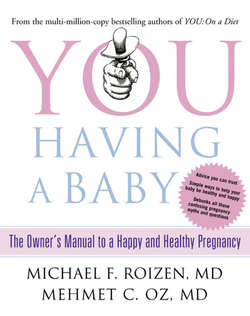Читать книгу You: Having a Baby: The Owner’s Manual to a Happy and Healthy Pregnancy - Michael Roizen F. - Страница 48
3 Eating for Who? Manage the Moments When You Feel Like Feeding on Everything—or Nothing at All
ОглавлениеHaving a baby brings out the math whiz in all of us. There’s a fair share of multiplication (8 diapers a day times 2.5 years equals about 7,000 changes per kid). There’s also plenty of division (you bathe her tonight, I’ll do it tomorrow). And unfortunately, we all do way too much subtraction (7 hours to sleep minus 3 feedings a night equals at least 1 whupped parent). But when it comes to the mother of all math equations, a lot of us get it all wrong.
See, when you become pregnant and think about your eating habits, the instinct—or at least the rationalization for many—is to follow this formula: My nutritional needs plus the baby’s nutritional needs equals “I’ll have a mashed potato sandwich with cheese, and make it a double.”
Right here, right now, let’s make a deal to take the “eating for two” mantra and pack it into our conversational Diaper Genie, never to see it, speak it, smell it, or think it ever again. The truth is that when you follow the science and look at adequate calorie consumption for growing a healthy baby, the more accurate principle that pregnant women should follow is “eating for 1.1.” (Has a nice ring to it, don’t ya think?)
Essentially, that means when you’re pregnant, you need to eat only 10 percent more than the number of calories you ordinarily eat to maintain your weight. We’ll explain how that formula works in more detail shortly. Then we’re going to discuss how you can cope with two eating extremes: those times when you crave the contents of the entire fridge and those times when you’re so sick that food is the very last thing you want to think about. The issue really becomes one of balance. You need to make sure that you get enough calories to feed your baby with the proper nutrients, but you also need to make sure you don’t overwhelm her with a fat-flooded placental buffet that will negatively influence her future health. What complicates the matter is that how you feel may not be in sync with what your body needs at any given time. When you’re sick and don’t feel like eating, you may very well need to. And when you’re famished and craving Ding Dong pizzas, it’s probably time to pull the reins and slow down.
As you know from our discussion about the placenta, virtually everything you do as a mother trickles down to your baby. And from our brief intro to epigenetics, you know that your actions influence not only his childhood health but also his health as an adult. More and more evidence suggests that adult diseases and conditions such as high blood pressure, obesity, and diabetes (and even his love of salami) are linked to mom’s early nutritional influence on the fetus. We also believe that it’s not a coincidence that we’re seeing more cesarean sections, more delivery complications, and more birth defects at the same time that we’re seeing our country’s nutritional habits score about a negative 37 on a scale of 1 to 10. That’s why we place so much emphasis, in this chapter and throughout the book, on the fuel you use to get yourself through your day—and get your baby through to the outside.
